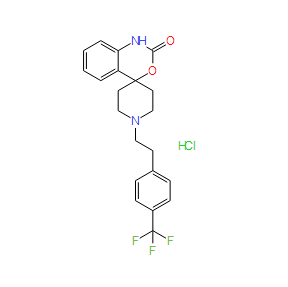| Cas No.: | 1173022-16-6 |
| Chemical Name: | 1′-[2-[4-(Trifluoromethyl)phenyl]ethyl]-spiro[4H-3,1-benzoxazine-4,4′-peperidin]-2(1H)-one |
| Synonyms: | RS-102895,RS 102895,RS102895 |
| SMILES: | C1CN(CCC12C3=CC=CC=C3NC(=O)O2)CCC4=CC=C(C=C4)C(F)(F)F.Cl |
| Formula: | C21H21F3N2O2.HCl |
| M.Wt: | 426.86 |
| Sotrage: | 2 years -20°C Powder, 2 weeks 4°C in DMSO, 6 months -80°C in DMSO |
| Description: | RS102895 hydrochloride is a potent CCR2 antagonist, with an IC50 of 360 nM, and shows no effect on CCR1. |
| In Vivo: | RS102895 (3 g/L) causes progressive decrease in pain threshold in rats with bone cancer pain (BCP) at day 3-9 after surgery via intrathecal injection, but the pain threshold increases after 12 days. RS102895 also potently reverses the pattern of NR2B, nNOS, and SIGIRR expression in spinal cord[3]. |
| In Vitro: | RS102895 hydrochloride is a potent CCR2 antagonist, with an IC50 of 360 nM, and shows no effect on CCR1. RS102895 also inhibits human α1a and α1d receptors, rat brain cortex 5HT1a receptor in cells with IC50s of 130, 320, 470 nM, respectively. RS102895 suppresses wild type and D284N mutant MCP-1 receptor (IC50, 550 nM and 568 nM, respectively), less potently inhibits D284A MCP-1 receptor (IC50, 1892 nM), and has no effects on E291A, E291Q, D284A/E291A or D284N/E291Q (IC50, >100,000 nM)[1]. RS102895 ameliorates the increased extracellular matrix (ECM) protein expression by inhibition of CCR2 at 10 μM, and obviously blocks fibronectin and type IV collagen protein expression in high glucose (HG)-stimulated mesangial cells (MCs) at 1 or 10 μM. RS102895 (10 μM) also abrogates the increased TGF-1 levels in MCs treated with MCP-1[2]. |

 DC Chemicals' products qualify for U.S. tariff exemptions. We guarantee no price increases due to customs duties and maintain stable supply, continuing to deliver reliable research solutions to our American clients.
DC Chemicals' products qualify for U.S. tariff exemptions. We guarantee no price increases due to customs duties and maintain stable supply, continuing to deliver reliable research solutions to our American clients.





















